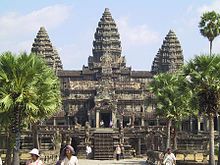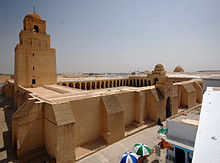
History of the world
Did you know...
This Schools selection was originally chosen by SOS Children for schools in the developing world without internet access. It is available as a intranet download. SOS Children has looked after children in Africa for forty years. Can you help their work in Africa?
The history of the world is the history of humanity, beginning with the Paleolithic Era. Distinct from the history of Planet Earth (which includes early geologic history and prehuman biological eras), world history comprises the study of archeological and written records, from ancient times on. Ancient recorded history begins with the invention of writing. However, the roots of civilization reach back to the period before the invention of writing. Prehistory begins in the Paleolithic Era, or "Early Stone Age," which is followed by the Neolithic Era, or New Stone Age, and the Agricultural Revolution (between 8000 and 5000 BCE) in the Fertile Crescent. The Neolithic Revolution marked a change in human history, as humans began the systematic husbandry of plants and animals. Agriculture advanced, and most humans transitioned from a nomadic to a settled lifestyle as farmers in permanent settlements. Nomadism continued in some locations, especially in isolated regions with few domesticable plant species; but the relative security and increased productivity provided by farming allowed human communities to expand into increasingly larger units, fostered by advances in transportation.
As farming developed, grain agriculture became more sophisticated and prompted a division of labor to store food between growing seasons. Labor divisions then led to the rise of a leisured upper class and the development of cities. The growing complexity of human societies necessitated systems of writing and accounting. Many cities developed on the banks of lakes and rivers; as early as 3000 BCE some of the first prominent, well-developed settlements had arisen in Mesopotamia, on the banks of Egypt's River Nile, and in the Indus River valley. Similar civilizations probably developed along major rivers in China, but archaeological evidence for extensive urban construction there is less conclusive.
The history of the Old World is commonly divided into Antiquity, up to 476 CE; the Middle Ages, from the 5th through 15th centuries, including the Islamic Golden Age (c.750 CE – c.1258 CE) and the early European Renaissance (beginning around 1300 CE); the Early Modern period, from the 15th century to the late 18th, including the Age of Enlightenment; and the Late Modern period, from the Industrial Revolution to the present, including Contemporary History. In the history of Western Europe, the ostensible " Fall of Rome" in 476 CE is commonly taken as signaling the end of antiquity and the start of the Middle Ages. By contrast, Eastern Europe saw a transition from the Roman Empire to the Byzantine Empire, which did not decline until much later.
In the mid-15th century, Johannes Gutenberg's invention of modern printing, employing movable type, revolutionized communication, helping end the Middle Ages and usher in the Scientific Revolution. By the 18th century, the accumulation of knowledge and technology, especially in Europe, had reached a critical mass that brought about the Industrial Revolution.
Elsewhere, including the ancient Near East, ancient China, and ancient India, historical timelines unfolded differently. By the 18th century, however, due to extensive world trade and colonization, the histories of most civilizations had become significantly intertwined (see Globalization). In the last quarter-millennium, the rate of growth of population, knowledge, technology, commerce, weapons destructiveness and environmental degradation has greatly accelerated, creating opportunities and perils that now confront the planet's human communities.
Prehistory
Early humans
Genetic measurements indicate that the ape lineage which would lead to Homo sapiens diverged from the lineage that would lead to chimpanzees (the closest living relative of modern humans) around five million years ago. It is thought that the Australopithecine genus, which were likely the first apes to walk upright, eventually gave rise to genus Homo. Anatomically modern humans arose in Africa about 200,000 years ago, and reached behavioural modernity about 50,000 years ago.
Modern humans spread rapidly from Africa into the frost-free zones of Europe and Asia around 60,000 years ago. The rapid expansion of humankind to North America and Oceania took place at the climax of the most recent Ice Age, when temperate regions of today were extremely inhospitable. Yet, humans had colonised nearly all the ice-free parts of the globe by the end of the Ice Age, some 12,000 years ago. Other hominids such as Homo erectus had been using simple wood and stone tools for millennia, but as time progressed, tools became far more refined and complex. At some point, humans began using fire for heat and cooking. They also developed language in the Palaeolithic period and a conceptual repertoire that included systematic burial of the dead and adornment of the living. Early artistic expression can be found in the form of cave paintings and sculptures made from wood and bone. During this period, all humans lived as hunter-gatherers, and were generally nomadic; this means they hunted and foraged for food, and moved constantly from place to place.
Rise of civilization
The Neolithic Revolution, beginning about 8,000 BCE, saw the development of agriculture, which drastically changed the human lifestyle. Farming permitted far denser populations, which in time organised into states. Agriculture also created food surpluses that could support people not directly engaged in food production. The development of agriculture permitted the creation of the first cities. These were centres of trade, manufacturing and political power with nearly no agricultural production of their own. Cities established a symbiosis with their surrounding countrysides, absorbing agricultural products and providing, in return, manufactured goods and varying degrees of military control and protection.
The development of cities was synonymous with the rise of civilization. Early civilizations arose first in lower Mesopotamia (3500 BCE), followed by Egyptian civilization along the Nile (3300 BCE) and the Harappan civilization in the Indus Valley (in present-day Pakistan; 3300 BCE). These societies developed a number of unifying characteristics, including a central government, a complex economy and social structure, sophisticated language and writing systems, and distinct cultures and religions. Writing was another pivotal development in human history, as it made the administration of cities and expression of ideas far easier.
As complex civilizations arose, so did complex religions, and the first of their kind apparently originated during this period. Inanimate entities such as the Sun, Moon, Earth, sky, and sea were often deified. Shrines developed, which evolved into temple establishments, complete with a complex hierarchy of priests and priestesses and other functionaries. Typical of the Neolithic was a tendency to worship anthropomorphic deities. Some of the earliest surviving written religious scriptures are the Pyramid Texts, produced by the Egyptians, the oldest of which date to between 2400 and 2300 BCE. Some archaeologists suggest, based on ongoing excavations of a temple complex at Göbekli Tepe ("Potbelly Hill") in southern Turkey, dating from c. 11,500 years ago, that religion predated the Agricultural Revolution rather than following in its wake, as had generally been assumed.
Antiquity
Timeline
- Dates are approximate, consult particular article for details

Cradles of civilization
The Bronze Age is part of the three-age system ( Stone Age, Bronze Age, Iron Age) that for some parts of the world describes effectively the early history of civilization. During this era the most fertile areas of the world saw city states and the first civilizations develop. These were concentrated in fertile river valleys: The Tigris and Euphrates in Mesopotamia, the Nile in Egypt, the Indus in the Indian subcontinent, and the Yangtze and Yellow River in China.
Sumer, located in Mesopotamia, is the first known complex civilization, developing the first city-states in the 4th millennium BCE. It was in these cities that the earliest known form of writing, cuneiform script, appeared c. 3000 BCE. Cuneiform writing began as a system of pictographs. These pictorial representations eventually became simplified and more abstract. Cuneiform texts were written on clay tablets, on which symbols were drawn with a blunt reed used as a stylus. Writing made the administration of a large state far easier.
Transport was facilitated by waterways—by rivers and seas. The Mediterranean Sea, at the juncture of three continents, fostered the projection of military power and the exchange of goods, ideas and inventions. This era also saw new land technologies, such as horse-based cavalry and chariots, that allowed armies to move faster.
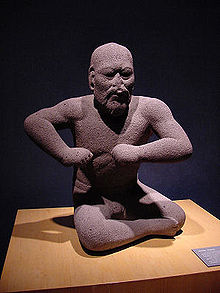
These developments led to the rise of empires. Such extensive civilizations brought peace and stability over wider areas. The first empire, controlling a large territory and many cities, developed in Egypt with the unification of Lower and Upper Egypt c. 3100 BCE. Over the next millennia, other river valleys would see monarchical empires rise to power. In the 24th century BCE, the Akkadian Empire arose in Mesopotamia; and c. 2200 BCE the Xia Dynasty arose in China.
Over the following millennia, civilizations would develop across the world. Trade would increasingly become a source of power as states with access to important resources or controlling important trade routes would rise to dominance. In c. 2500 BCE, the Kingdom of Kerma developed in Sudan, south of Egypt. In modern Turkey the Hittites controlled a large empire and by 1600 BCE, Mycenaean Greece began to develop. In India this era was the Vedic period, which laid the foundations of Hinduism and other cultural aspects of early Indian society, and ended in the 6th century BCE. From around 550 BCE, many independent kingdoms and republics known as the Mahajanapadas were established across the country.
As complex civilizations arose in the Eastern Hemisphere, most indigenous societies in the Americas remained relatively simple for some time, fragmented into diverse regional cultures. During the Formative stage in Mesoamerica, (about 1500 BCE to 500 CE), more complex and centralized civilizations began to develop, mostly in what is now Mexico, Central America, and Peru. They include civilizations such as the Maya, Zapotec, Moche, and Nazca. They developed agriculture as well, growing maize and other crops unique to the Americas, and creating a distinct culture and religion. These ancient indigenous societies would be greatly affected by European contact during the early modern period.
Axial Age
Beginning in the 8th century BCE, the so-called "Axial Age" saw a set of transformative religious and philosophical ideas develop, mostly independently, in many different locations. During the 6th century BCE, Chinese Confucianism, Indian Buddhism and Jainism, and Jewish Monotheism all developed. (Karl Jaspers' Axial Age theory also includes Persian Zoroastrianism on this list, but other scholars dispute Jaspers' timeline for Zoroastrianism.) In the 5th century BCE Socrates and Plato made significant advances in the development of Ancient Greek philosophy.
In the east, three schools of thought were to dominate Chinese thinking until the modern day. These were Taoism, Legalism and Confucianism. The Confucian tradition, which would attain dominance, looked for political morality not to the force of law but to the power and example of tradition. Confucianism would later spread into the Korean peninsula and toward Japan.
In the west, the Greek philosophical tradition, represented by Socrates, Plato, and Aristotle, was diffused throughout Europe and the Middle East in the 4th century BCE by the conquests of Alexander III of Macedon, more commonly known as Alexander the Great.
Regional empires
The millennium from 500 BCE to 500 CE saw a series of empires of unprecedented size develop. Well-trained professional armies, unifying ideologies, and advanced bureaucracies created the possibility for emperors to rule over large domains, whose populations could attain numbers upwards of tens of millions of subjects.
Some areas experienced slow but steady technological advancements, with important developments such as the stirrup and moldboard plow arriving every few centuries. There were, however, in some regions, periods of rapid technological progress. Most important, perhaps, was the Mediterranean area during the Hellenistic period, when hundreds of technologies were invented. Such periods were followed by periods of technological decay, as during the Roman Empire's decline and fall and the ensuing early medieval period.
The great empires depended on military annexation of territory and on the formation of defended settlements to become agricultural centres. The relative peace that the empires brought encouraged international trade, most notably the massive trade routes in the Mediterranean that had been developed by the time of the Hellenistic Age, and the Silk Road.
The empires faced common problems associated with maintaining huge armies and supporting a central bureaucracy. These costs fell most heavily on the peasantry, while land-owning magnates increasingly evaded centralised control and its costs. Barbarian pressure on the frontiers hastened internal dissolution. China's Han Empire fell into civil war in 220 CE, while its Roman counterpart became increasingly decentralized and divided about the same time.
In the west, the Greeks (and later the Romans) established their own cultures; whose practices, laws, and customs are considered the foundation of contemporary western civilization. Beginning in the 3rd century BCE, the Romans began expanding their territory through conquest and colonization. By the reign of Emperor Augustus (late 1st century BCE), Rome controlled all the lands surrounding the Mediterranean. By the reign of Emperor Trajan (early 2nd century CE), Rome controlled much of the land from England to Mesopotamia.
In the 3rd century BCE, most of South Asia was united into the Maurya Empire by Chandragupta Maurya and flourished under Ashoka the Great. From the 3rd century CE, the Gupta dynasty oversaw the period referred to as ancient India's Golden Age. Empires in Southern India included those of the Chalukyas,the Rashtrakutas, the Hoysalas, the Cholas and the Vijayanagara Empire. Science, engineering, art, literature, astronomy, and philosophy flourished under the patronage of these kings.
Meanwhile, East Asia saw the rise of the Han Dynasty, which was comparable in power and influence to the Roman Empire that lay on the other side of the Silk Road. While the Romans constructed a vast military of unprecedented power, Han China was developing advanced cartography, shipbuilding, and navigation. The East invented blast furnaces and were capable of creating finely tuned copper instruments. As with other empires during the Classical Period, Han China advanced in strides in areas of government, education, mathematics, astronomy, and technology, among others.
By the 1st century CE the Aksumite Empire had established itself as a major trading Empire, dominating its neighbours in South Arabia and Kush and controlling the Red Sea trade. They minted their own currency and carved enormous monolithic stelea such as the Obelisk of Axum to mark their Emperors graves.
From the 4th to 6th centuries, northern India was ruled by the Guptas. In southern India, three prominent Dravidian kingdoms emerged: Cheras, Cholas and Pandyas. The ensuing stability contributed to heralding in the golden age of Hindu culture in the 4th and 5th centuries.
Successful regional empires were also established in the Americas starting from around 2000 BCE. In Mesoamerica, vast pre-Columbian societies were being built, the most notable being the Maya and Aztecs. As the mother culture of the Olmecs gradually declined, the great Mayan city-states slowly rose in number and prominence, and Maya culture spread throughout Yucatán and surrounding areas. The later empire of the Aztecs was built on neighboring cultures and was influenced by conquered peoples such as the Toltecs.
In South America, the 14th and 15th centuries saw the rise of the Inca. The Inca Empire of Tawantinsuyu, with its capital at Cusco, spanned the entire Andes Mountain Range, making it the most extensive Pre-Columbian civilization. The Inca were prosperous and advanced, known for an excellent road system and unrivaled masonry.
Declines and falls
The great empires of Eurasia were all located on temperate coastal plains. From the Central Asian steppes, horse-based nomads (Mongols, Turks) dominated a large part of the continent. The development of the stirrup, and the breeding of horses strong enough to carry a fully armed archer, made the nomads a constant threat to the more settled civilizations.
The gradual break-up of the Roman Empire, spanning several centuries after the 2nd century CE, coincided with the spread of Christianity westward from the Middle East. The Western Roman Empire fell under the domination of Germanic tribes in the 5th century, and these polities gradually developed into a number of warring states, all associated in one way or another with the Roman Catholic Church. The remaining part of the Roman Empire, in the eastern Mediterranean, would henceforth be the Byzantine Empire. Centuries later, a limited unity would be restored to western Europe through the establishment of the Holy Roman Empire in 962, comprising a number of states in what is now Germany, Austria, Switzerland, Czechia, Belgium, Italy, and parts of France.
In China, dynasties would similarly rise and fall. After the fall of the Eastern Han Dynasty and the demise of the Three Kingdoms, nomadic tribes from the north began to invade in the 4th century, eventually conquering areas of Northern China and setting up many small kingdoms. The Sui Dynasty reunified China in 581, and under the succeeding Tang Dynasty (618–907) China entered a second golden age. The Tang Dynasty also splintered, however, and after half a century of turmoil the Northern Song Dynasty reunified China in 982. Yet pressure from nomadic empires to the north became increasingly urgent. North China was lost to the Jurchens in 1141, and the Mongol Empire conquered all of China in 1279, as well as almost half of Eurasia's landmass.
Middle Ages
The Middle Ages centre on the Eurasian world and are commonly dated from the fall of the Western Roman Empire in the 5th century. While the Western Roman Empire fragmented into numerous separate kingdoms, the Eastern Roman, or Byzantine, Empire survived until late in the Middle Ages. The period also corresponds to the Islamic conquests, subsequent Islamic golden age, and commencement and expansion of the Arab slave trade, followed by the Mongol invasions in the Middle East and Central Asia. South Asia saw a series of middle kingdoms of India, followed by the establishment of Islamic empires in India. The Chinese Empire experienced the successive Sui, Tang, Liao, Jin, Yuan and Ming Dynasties. Middle Eastern trade routes along the Indian Ocean, and the Silk Road through the Gobi Desert, provided limited economic and cultural contact between Asian and European civilizations. While the Middle Ages held sway in Europe, civilizations in the Americas, such as the Inca, Maya, and Aztec, continued to flourish, then ended at different times.
Islamic growth
Muslims began their expansion in Late Antiquity and the Early Middle Ages. They came to conquer most of the Middle East, North Africa, and parts of Europe. The knowledge and skills of the ancient Middle East, of Greece and of Persia were learned by Muslims in the Middle Ages. Muslims added new and important innovations from outside, such as the manufacture of paper from China and decimal positional numbering from India. Much of this learning and development can be linked to geography. Even prior to Islam's presence the city of Mecca had served as a centre of trade in Arabia, and Muhammad was a merchant. With the new tradition of the Hajj, the pilgrimage to Mecca, the city became even more a centre for exchanging goods and ideas. The influence held by Muslim merchants over African-Arabian and Arabian-Asian trade routes was tremendous. As a result, Islamic civilization grew and expanded on the basis of its merchant economy, in contrast to the Christians, Indians and Chinese who based their societies on an agricultural landholding nobility. Merchants brought goods and their faith to China (resulting in a present-day population of some 37 million Chinese Muslims, mainly ethnic Turkic Uyghurs, whose territory was annexed to China), India, southeast Asia, and the kingdoms of western Africa and returned with new discoveries and inventions.
Medieval Europe
Europe during the Early Middle Ages was characterized by depopulation, deurbanization, and barbarian invasion, all of which had begun in Late Antiquity. The barbarian invaders formed their own new kingdoms in the remains of the Western Roman Empire. In the 7th century, North Africa and the Middle East, once part of the eastern empire, became part of the Caliphate after conquest by Muhammad's successors. Although there were substantial changes in society and political structures, the break was not as extreme as once put forth by historians, with most of the new kingdoms incorporating as many of the existing Roman institutions as they could. Christianity expanded in western Europe and monasteries were founded. In the 7th and 8th centuries the Franks, under the Carolingian dynasty, established an empire covering much of western Europe; it lasted until the 9th century, when it succumbed to pressure from new invaders – the Vikings, Magyars, and Saracens.
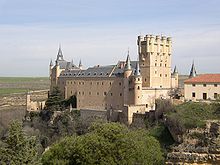
During the High Middle Ages, which began after 1000, the population of Europe increased greatly as new technological and agricultural innovations allowed trade to flourish and crop yields to increase. Manorialism – the organization of peasants into villages that owed rents and labor service to nobles – and feudalism – a political structure whereby knights and lower-status nobles owed military service to their overlords in return for the right to rents from lands and manors – were two of the ways of organizing medieval society that developed during the High Middle Ages. Kingdoms became more centralized after the decentralizing effects of the breakup of the Carolingian Empire. The Crusades, which were first preached in 1095, were an attempt by western Christians to regain control of the Holy Land from the Muslims, and succeeded long enough to establish some Christian states in the Near East. Intellectual life was marked by scholasticism and the founding of universities, while the building of Gothic cathedrals was one of the outstanding artistic achievements of the age.
The Late Middle Ages were marked by a number of difficulties and calamities. Famine, plague and war decimated the population of western Europe. The Black Death alone killed approximately a third of the population between 1347 and 1350. It was one of the deadliest pandemics in human history. Starting in Asia, the disease reached Mediterranean and western Europe during the late 1340s, and killed tens of millions of Europeans in six years; between a third and a half of the population.
The Middle Ages witnessed the first sustained urbanization of northern and western Europe. Many modern European states owe their origins to events unfolding in the Middle Ages; present European political boundaries are, in many regards, the result of the military and dynastic achievements during this tumultuous period. The Middle Ages lasted until the beginning of the Early Modern Period in the 16th century, marked by the rise of nation-states, the division of Western Christianity in the Reformation, the rise of humanism in the Italian Renaissance, and the beginnings of European overseas expansion which allowed for the Columbian Exchange.
Medieval Sub-Saharan Africa
Medieval Sub-Saharan Africa was home to many different civilizations. The Aksumite Empire declined in the 7th century as Islam cut it off from its Christian allies and its people moved further into the Ethiopian highlands for protection. They eventually gave way to the Zagwe Dynasty who are famed for their rock cut architecture at Lalibela. The Zagwe would then fall to the Solomonic Dynasty who claimed descent from the Aksumite emperors and would rule the country well into the 20th century. In the West African Sahel region, many Islamic empires rose, such as the Ghana Empire, the Mali Empire, the Songhai Empire, and the Kanem Empire. They controlled the trans-Saharan trade in gold, ivory, salt and slaves.
South of the Sahel civilisations rose in the coastal forests where horses and camels could not survive. These include the Yoruba city of Ife (noted for its naturalistic art) and the Oyo Empire, the Benin Empire of the Edo people centered in Benin city, the Igbo Kingdom of Nri which produced advanced bronze art at Igbo Ukwu, and the Akan who are noted for their intricate architecture.
In what is now modern Zimbabwe various kingdoms evolved from the Kingdom of Mapungubwe in modern South Africa. They flourished through trade with the Swahili people on the East African coast. They built large defensive stone structures without mortar such as Great Zimbabwe, capital of the Kingdom of Zimbabwe, Khami, capital of Kingdom of Butua and Danamombe (Dhlo-Dhlo), capital of the Rozwi Empire. The Swahili people themselves were the inhabitants of the East African coast from Kenya to Mozambique who traded extensively with Asians and Arabs, who introduced them to Islam. They built many port cities such as Mombasa, Zanzibar, and Kilwa, which were known to Chinese sailors under Zheng He and Islamic geographers.
The Americas
This period saw the rise of the Mississippian culture in the modern United States c. 800 CE. The Aztec came to dominate much of Mesoamerica in the 14th and 15th centuries, and the Inca came to dominate the Andes in the 15th century. In Mesoamerica, the Teotihuacan civilization fell and the Classic Maya collapse occurred.
Southeast Asia
The beginning of the Middle Ages in Southeast Asia saw the fall of the Kingdom of Funan to the Chenla Kingdom, which was then replaced by the Khmer Empire. The Khmer's capital city Angkor was the largest city in the world prior to the industrial age and contained over a thousand temples, the most famous being Angkor Wat. The Sukhothai and Ayutthaya kingdoms were major powers of the Thai people who were influenced by the Khmer. The Pagan Kingdom also rose to prominence in modern Burma. It was during this period that Islam spread to Indonesia.
Modern history
Modern history (the "modern period," the "modern era," "modern times") is history of the period following the Middle Ages. " Contemporary history" is history that only covers events from c. 1900 to the present day.
Early modern period
" Early modern period" is a term used by historians to refer to the period in Western Europe and its first colonies that spans the centuries between the Middle Ages and the Industrial Revolution – roughly 1500 to 1800. The early modern period is characterized by the rise to importance of science and by increasingly rapid technological progress, secularized civic politics, and the nation-state. Capitalist economies began their rise, initially in northern Italian republics such as Genoa. The early modern period also saw the rise and dominance of the mercantilist economic theory. As such, the early modern period represents the decline and eventual disappearance, in much of the European sphere, of feudalism, serfdom and the power of the Catholic Church. The period includes the late decades of the Protestant Reformation, the disastrous Thirty Years' War, the Age of Discovery, the European colonization of the Americas, and the peak of European witch-hunting.
This period saw a decline in many African civilizations and an advancement in others. Ethiopia entered the Zemene Mesafint (Age of Princes) in 1769 when the Emperor became a figurehead and the country was ruled by warlords, though it later recovered under Emperor Tewodros II. The Swahili Coast declined after coming under Portuguese and Omani control. The Songhai Empire fell to the Moroccans in 1591 when they invaded with guns. The kingdom of Zimbabwe gave way to smaller kingdoms such as Mutapa and Butua. Other civilizations in Africa advanced during this period; the Oyo Empire went through its golden age, as did the Benin Empire. The Ashanti Empire rose to power in what is modern day Ghana in 1670. The Kingdom of Kongo also thrived during this period. European exploration of Africa reached its zenith at this time.
Renaissance
Europe's Renaissance, beginning in the 14th century, consisted of the rediscovery of the classical world's scientific contributions, and in the economic and social rise of Europe. But the Renaissance also engendered a culture of inquisitiveness which ultimately led to Humanism and the Scientific Revolution. Although it saw social and political upheaval and revolutions in many intellectual pursuits, the Renaissance is perhaps known best for its artistic developments and the contributions of such polymaths as Leonardo da Vinci and Michelangelo, who inspired the term " Renaissance man".
European expansion
During this period, European powers came to dominate most of the world. One theory of why that happened holds that Europe's geography played an important role in its success. The Middle East, India and China are all ringed by mountains and oceans but, once past these outer barriers, are nearly flat. By contrast, the Pyrenees, Alps, Apennines, Carpathians and other mountain ranges run through Europe, and the continent is also divided by several seas. This gave Europe some degree of protection from the peril of Central Asian invaders. Before the era of firearms, these nomads were militarily superior to the agricultural states on the periphery of the Eurasian continent and, if they broke out into the plains of northern India or the valleys of China, were all but unstoppable. These invasions were often devastating. The Golden Age of Islam was ended by the Mongol sack of Baghdad in 1258. India and China were subject to periodic invasions, and Russia spent a couple of centuries under the Mongol-Tatar yoke. Central and western Europe, logistically more distant from the Central Asian heartland, proved less vulnerable to these threats.
Geography contributed to important geopolitical differences. For most of their histories, China, India and the Middle East were each unified under a single dominant power that expanded until it reached the surrounding mountains and deserts. In 1600 the Ottoman Empire controlled almost all the Middle East, the Ming Dynasty ruled China, and the Mughal Empire held sway over India. By contrast, Europe was almost always divided into a number of warring states. Pan-European empires, with the notable exception of the Roman Empire, tended to collapse soon after they arose. Another doubtless important geographic factor in the rise of Europe was the Mediterranean Sea, which, for millennia, had functioned as a maritime superhighway fostering the exchange of goods, people, ideas and inventions.
Nearly all the agricultural civilizations have been heavily constrained by their environments. Productivity remained low, and climatic changes easily instigated boom-and-bust cycles that brought about civilizations' rise and fall. By about 1500, however, there was a qualitative change in world history. Technological advance and the wealth generated by trade gradually brought about a widening of possibilities.
Many have also argued that Europe's institutions allowed it to expand, that property rights and free-market economics were stronger than elsewhere due to an ideal of freedom peculiar to Europe. In recent years, however, scholars such as Kenneth Pomeranz have challenged this view, although the revisionist approach to world history has been met with criticism for systematically "downplaying" European achievements.
Europe's maritime expansion unsurprisingly — given the continent's geography — was largely the work of its Atlantic states: Portugal, Spain, England, France, and the Netherlands. Initially the Portuguese and Spanish Empires were the predominant conquerors and source of influence, and their union resulted in the Iberian Union, the first global empire, on which the " sun never set". Soon the more northern English, French and Dutch began to dominate the Atlantic. In a series of wars fought in the 17th and 18th centuries, culminating with the Napoleonic Wars, Britain emerged as the new world power.
This era in European culture saw the Age of Enlightenment which led to the Scientific Revolution.
Modern period
The Scientific Revolution changed humanity's understanding of the world and led to the Industrial Revolution, a major transformation of the world's economies. The Scientific Revolution in the 17th century had made little immediate impact on industrial technology; only in the second half of the 18th century did scientific advances begin to be applied significantly to practical invention. The Industrial Revolution began in Great Britain and used new modes of production — the factory, mass production, and mechanisation — to manufacture a wide array of goods faster and using less labour than previously. The Age of Enlightenment also led to the beginnings of modern democracy in the late-18th century American and French Revolutions. Democracy and republicanism would grow to have a profound effect on world events and on quality of life.
After Europeans had achieved influence and control over the Americas, the imperial activities of the West turned to the lands of the East and Asia. In the 19th century the European states had social and technological advantage over Eastern lands. Britain gained control of the Indian subcontinent, Egypt and the Malay Peninsula; the French took Indochina; while the Dutch cemented their control over the Dutch East Indies. The British also colonized Australia, New Zealand and South Africa with large numbers of British colonists emigrating to these colonies. Russia colonised large pre-agricultural areas of Siberia. In the late 19th century, the European powers divided the remaining areas of Africa. Within Europe, economic and military challenges created a system of nation states, and ethno-linguistic groupings began to identify themselves as distinctive nations with aspirations for cultural and political autonomy. This nationalism would become important to peoples across the world in the 20th century.
During the Industrial Revolution, the world economy became reliant on coal as a fuel, as new methods of transport, such as railways and steamships, effectively shrank the world. Meanwhile, industrial pollution and environmental damage, present since the discovery of fire and the beginning of civilization, accelerated drastically.
The advantages that Europe had developed by the mid-18th century were two: an entrepreneurial culture, and the wealth generated by the Atlantic trade (including the African slave trade). By the late 16th century, silver from the Americas accounted for the Spanish empire's wealth. The profits of the slave trade and of West Indian plantations amounted to 5% of the British economy at the time of the Industrial Revolution. While some historians conclude that, in 1750, labour productivity in the most developed regions of China was still on a par with that of Europe's Atlantic economy (see the NBER Publications by Carol H. Shiue and Wolfgang Keller), other historians like Angus Maddison hold that the per-capita productivity of western Europe had by the late Middle Ages surpassed that of all other regions.
Contemporary history
1900–45
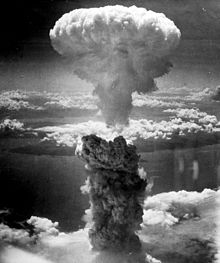
The 20th century opened with Europe at an apex of wealth and power, and with much of the world under its direct colonial control or its indirect domination. Much of the rest of the world was influenced by heavily Europeanized nations: the United States and Japan. As the century unfolded, however, the global system dominated by rival powers was subjected to severe strains, and ultimately yielded to a more fluid structure of independent nations organized on Western models.
This transformation was catalysed by wars of unparalleled scope and devastation. World War I destroyed many of Europe's empires and monarchies, and weakened Britain and France. In its aftermath, powerful ideologies arose. The Russian Revolution of 1917 created the first communist state, while the 1920s and 1930s saw militaristic fascist dictatorships gain control in Italy, Germany, Spain and elsewhere.
Ongoing national rivalries, exacerbated by the economic turmoil of the Great Depression, helped precipitate World War II. The militaristic dictatorships of Europe and Japan pursued an ultimately doomed course of imperialist expansionism. Their defeat opened the way for the advance of communism into Central Europe, Yugoslavia, Bulgaria, Romania, Albania, China, North Vietnam and North Korea.
1945–2000
After World War II ended in 1945, the United Nations was founded in the hope of allaying conflicts among nations and preventing future wars. The war had, however, left two nations, the United States and the Soviet Union, with principal power to guide international affairs. Each was suspicious of the other and feared a global spread of the other's political-economic model. This led to the Cold War, a forty-year stand-off between the United States, the Soviet Union, and their respective allies. With the development of nuclear weapons and the subsequent arms race, all of humanity were put at risk of nuclear war between the two superpowers. Such war being viewed as impractical, proxy wars were instead waged, at the expense of non-nuclear-armed Third World countries.
The Cold War lasted to the 1990s, when the Soviet Union's communist system began to collapse, unable to compete economically with the United States and western Europe; the Soviets' Central European " satellites" reasserted their national sovereignty, and in 1991 the Soviet Union itself disintegrated. The United States for the time being was left as the "sole remaining superpower".
In the early postwar decades, the African and Asian colonies of the Belgian, British, Dutch, French and other west European empires won their formal independence. These nations faced challenges in the form of neocolonialism, poverty, illiteracy and endemic tropical diseases.
Many Western and Central European nations gradually formed a political and economic community, the European Union, which expanded eastward to include former Soviet satellites.
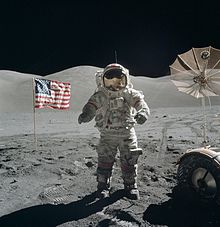
The 20th century saw explosive progress in science and technology, and increased life expectancy and standard of living for much of humanity. As the developed world shifted from a coal-based to a petroleum-based economy, new transport technologies, along with the dawn of the Information Age, led to increased globalization. Space exploration reached throughout the solar system. The structure of DNA, the template of life, was discovered, and the human genome was sequenced, a major milestone in the understanding of human biology and the treatment of disease. Global literacy rates continued to rise, and the percentage of the world's labor pool needed to produce humankind's food supply continued to drop.
The technologies of sound recordings, motion pictures, and radio and television broadcasting produced a means for rapid dissemination of information and entertainment. Then, in the last decade of this century, a rapid increase took place in the use of computers, including personal ones. A global communication network emerged in the Internet. One-way mass media gave way to individual communication in what has been called a shift from the fourth to a fifth civilization.
The century saw several man-made global threats emerge or become more serious or widely recognized, including nuclear proliferation, global climate change, deforestation, overpopulation, near-Earth asteroids and comets, and the dwindling of global natural resources (particularly fossil fuels).
21st century
The 21st century has been marked by economic globalization, with consequent risk to interlinked economies, and by the expansion of communications with mobile phones and the Internet. Worldwide demand and competition for resources has risen due to growing populations and industrialization, mainly in India, China and Brazil. This demand is causing increased levels of environmental degradation and a growing threat of global warming. That in turn has spurred the development of alternate or renewable sources of energy (notably solar energy and wind energy), proposals for cleaner fossil fuel technologies, and consideration of expanded use of nuclear energy (somewhat dampened by nuclear plant accidents).




